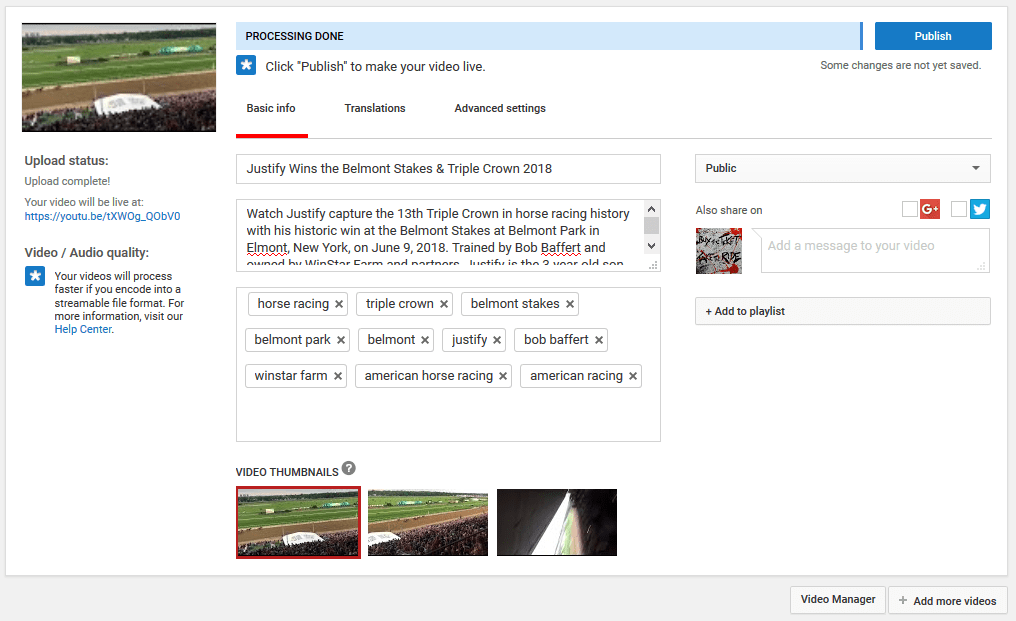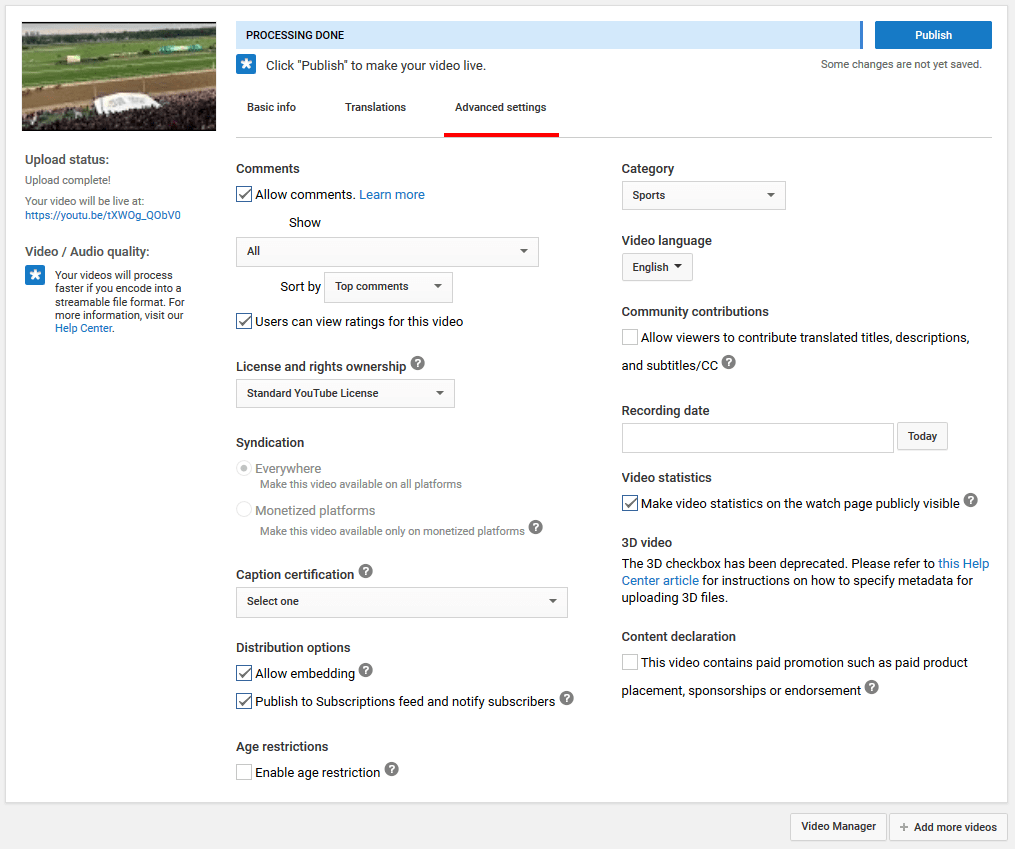Video optimization, or YouTube SEO as it is becoming more commonly called, gives good video content the ability to have greater visibility against other videos – not just in YouTube search, but also in Google search and other search engines like Bing.
Video Optimization That Will Have an Impact
Video content is an unrivaled tool when it comes to telling a story to the masses, and it’s only growing in popularity as more advanced technology continues to hit the market.
Human beings have pretty much always enjoyed — sometimes even relied on — video content. Fun fact: movies helped pull us out of the Great Depression.
Video has only become more common (Hello, Internet!), useful, and better-produced since then. Today, it’s accessible in just seconds to anyone from nearly anywhere in the world.
But now, with so many people uploading video to the web and all the video content that is already living on the internet — increasing drastically in volume every day — how can marketers get their content to stand out against “the other guys?”
Use these basic and advanced tips to help you and your content team succeed against other video publishers that aren’t taking advantage of the video optimization tactics.
YouTube SEO Basics
There’s a reason why YouTube lets users manually input a title, description, and tags, as well as choose an optimal video thumbnail and add the new video to a playlist.
It’s all about making it easy for your audience to find you.
All those options should be utilized from the first time the video is uploaded, with the exception of maybe adding it to a playlist – that can wait until the appropriate playlist(s) is created, adding even more visibility to your video.
Title
Use keywords to focus on user intent and how those keywords match up with what the video content actually offers users.
Don’t worry about adding brand names to your titles (that’s usually already the channel name anyway). Focus on the important elements.
Use keyword research to get the most out of all basic YouTube publishing features where you can leverage keywords and relevancy.
You only have about 65-70 characters (including spaces) to say what’s important, so be sure to use that valuable real estate to capitalize.
YouTube allows 100 characters with spaces, but titles will be truncated depending on where they are showing up.
The title is one of the first things users see when your video appears on a page, shows up in search, or is shared on social media. Make it count.
Description
Like your title, your description contains keywords, reflects the content in the video, and is one of the first things a user sees.
Remember that you’re constructing a description about the video, not an advertisement or promotion.
A quality description has more details than a title, but shouldn’t be too long.
Your description should entice a user to watch the video because the information given leads the person to believe the video was something they were looking for.
The description should also include at least one link, typically back to the brand website, perhaps to a page specific to the content in the video.
I consider two links in a description a sweet spot (one at end of the first sentence and one in the last sentence), but keep in mind it’s a way to give users more information. You shouldn’t drown out a link or two with five links adding no real value.
I always recommend the following:
- Write a two- to three-sentence description.
- Add at least one link.
- Keep it around 300 characters, including spaces, or less.
YouTube allows 500 characters, but by no means do you need to use them all. In fact, you probably shouldn’t.
Tags
Tags are fairly unique to YouTube and are helpful for classifying content.
Only use keywords that are actually relevant to your video. Don’t add irrelevant tags in the hopes you’ll get more visibility (you won’t – or, if you do, you’ll only anger your viewers).
Tags help users and Google (and other search engines) better understand your video content.
Thumbnail
This is pretty simple. Pick an enticing picture.
Don’t pick something of a title slide or anything diluted by writing; pick a still image that users are going to be interested in and could possibly generate lots of clicks.
Again, don’t do anything tricky in an attempt to deceive users.
Playlist
Use these to get expanded reach and visibility on your videos.
However, there’s little-to-no pressure to get videos added to playlists – especially right away.

Translations
YouTube offers content creators the ability to translate videos into other languages.
This is useful when publishing global content intended for an international audience or when directed a specific demographic target that speaks a different language than English.
Most U.S.-based brands shouldn’t need this, but the instructions to translate are easy to follow if/when you do.
Language
If you’re uploading a video in English, and most or all your videos are going to be in English, select it from the Original language drop-down.
Also check “Default for new uploads” so that future uploads are automatically listed in English.
This will save you one step moving forward.

Advanced Settings
YouTube’s advanced settings offer a variety of options for video optimizations.
Some may seem sensible, others not so much.
Here’s which advanced settings changes you should make for your video and how to do it.
Comments
While it seems like a gift from the internet Gods to be able to disable all comments on a video, it will actually hurt your video’s visibility quite significantly.
Comments are one of the signals used by YouTube to determine relevancy, quality, and recency of videos.
Be sure comments are allowed by checking the box.
Distribution Rights
Allowing embedding of your video is going to likely increase the rate at which it is shared and embedded since it gives users the best on-site experience.
Anyone could add it to their website, including a news station or blogger.
Publishing the video to Subscriptions feeds and notifying subscribers is also a default best practice that helps the video be found and watched.
Age Restrictions
Videos shouldn’t have age restrictions added, unless there is explicit content that requires it.
What defines explicit may vary from person to person but “violence, disturbing imagery, nudity, sexually suggestive content, and portrayal of dangerous or illegal activities” may all be worth age restrictions, according to YouTube.
When age restriction is activated, all viewers must be signed into YouTube and over the age of 18.
Category
There are 15 different categories to choose from, and it helps YouTube recommend a video based on content criteria and other users’ behavior.
Most videos should have a category they match up with quite literally, but if for some reason a video can’t easily be categorized, I recommend using the default “Entertainment” tag.
Video Language
As mentioned above, this feature is designed to help the right content find the right users. If your video is in English, be sure it’s selected here if not already.
Community Contributions
Unless it’s part of a specifically designed feature or campaign, allowing viewers to contribute to translated titles, descriptions, and subtitles is not ideal.
Video Statistics
While it has no real effect on the overall visibility of the video, enabling video statistics on the watch page when viewers click the chart icon below the video. This can be either turned on or off, but it typically enabled.

Additional Optimizations All Videos Should Have
In addition to the above optimization techniques, some other basic optimizations can help make your videos more visible, but also perform better in general:
Include a Clear Call-To-Action (CTA)
Many great videos’ effect and engagement end when the video does. Don’t let that be the case.
Offer viewers clear next steps so that they can:
- Learn more about the video.
- Proceed to your website and learn more about the brand and what it has to offer.
- Potentially convert as a referral visitor from YouTube.
YouTube annotations are a great tool to use for CTAs.
Don’t Try to Oversell Yourself
YouTube is a place for people to educate themselves and feel inspired; rarely are users trying to be sold products, or even on brands.
Transcribe Your Content
This is oftentimes overlooked because it’s a tedious and laborious task, but it helps YouTube and search engines better understand the video and its content better than any other way.
It’s like crawling a website; you can’t crawl a video the same way you can text.
Distribute Your Content
Content should be shared across all social channels and in relevant communities and forums to extend reach.
It’s also worthwhile to put ad dollars behind the video content, as the more eyes that watch it, the better it performs.
Get the ball rolling out of the gate with optimized content, and you should see consistent video success for your content and your channel.
Content That Wins on YouTube & Why
Remember, there are a variety of signals that go into YouTube rankings and visibility:
- Watch time: How long a viewer watches a video.
- Keywords: Illustrate relevance to a search query.
- Subscribers: A channel with hundred or thousands of subscribers is going to perform better than a channel with 15 subscribers. This a behavioral signal signifying the channel is an authority on certain topics and trusted by others.
- Engagement: Likes, dislikes, and comments are all helpful signals that help YouTube, Google, and other search engines realize a video is worthy of more visibility.
- Video length: YouTube content shouldn’t be too long. Users should be interested in the content and watch it to get the real value from it.
Summary
An optimized YouTube video in one that:
- Is relevant to the user and/or their search query.
- Includes relevant keywords.
- Engages users, compelling them to watch most, if not all, of the video.
- Has a clear CTA.
- Includes at least one link that points to a relevant site for more information.
These optimizations are easy, straightforward, and helpful when producing quality video content that should be distributed.
And they make all the difference.
More YouTube SEO Resources:
Image Credits
All screenshots taken by author, July 2018.
Subscribe to SEJ
Get our daily newsletter from SEJ’s Founder Loren Baker about the latest news in the industry!
